Profiles. The 2023 Vuelta a Espana will be taking place from the 26th of August to the 17th of September 2023. The Spanish Grand Tour is the final one of the season, one that consistently delivers a balanced mix of mountainous, hilly and flat stages, always giving opportunity aswell to the time-trialist, and those who are resorting to the Vuelta for their final big chances of the year to take a prestigious win.
In this article the list of stages for the 2023 edition is listed, as revealed on the 10th of January in the race presentation in Barcelona, Spain. It will be a mountainous race as for usual. Several details were already heavily rumoured before the reveal, such as summit finishes at Andorra, Col du Tourmalet and the Alto de l'Angliru.
Also read
PREVIEW | Vuelta a Espana 2023 - Evenepoel faces Roglic and Vingegaard; Angliru headlines brutal mountainous route
Final startlist Vuelta a Espana with Evenepoel, Roglic, Vingegaard, Ayuso, Almeida, Ganna, Thomas, Landa and Mas
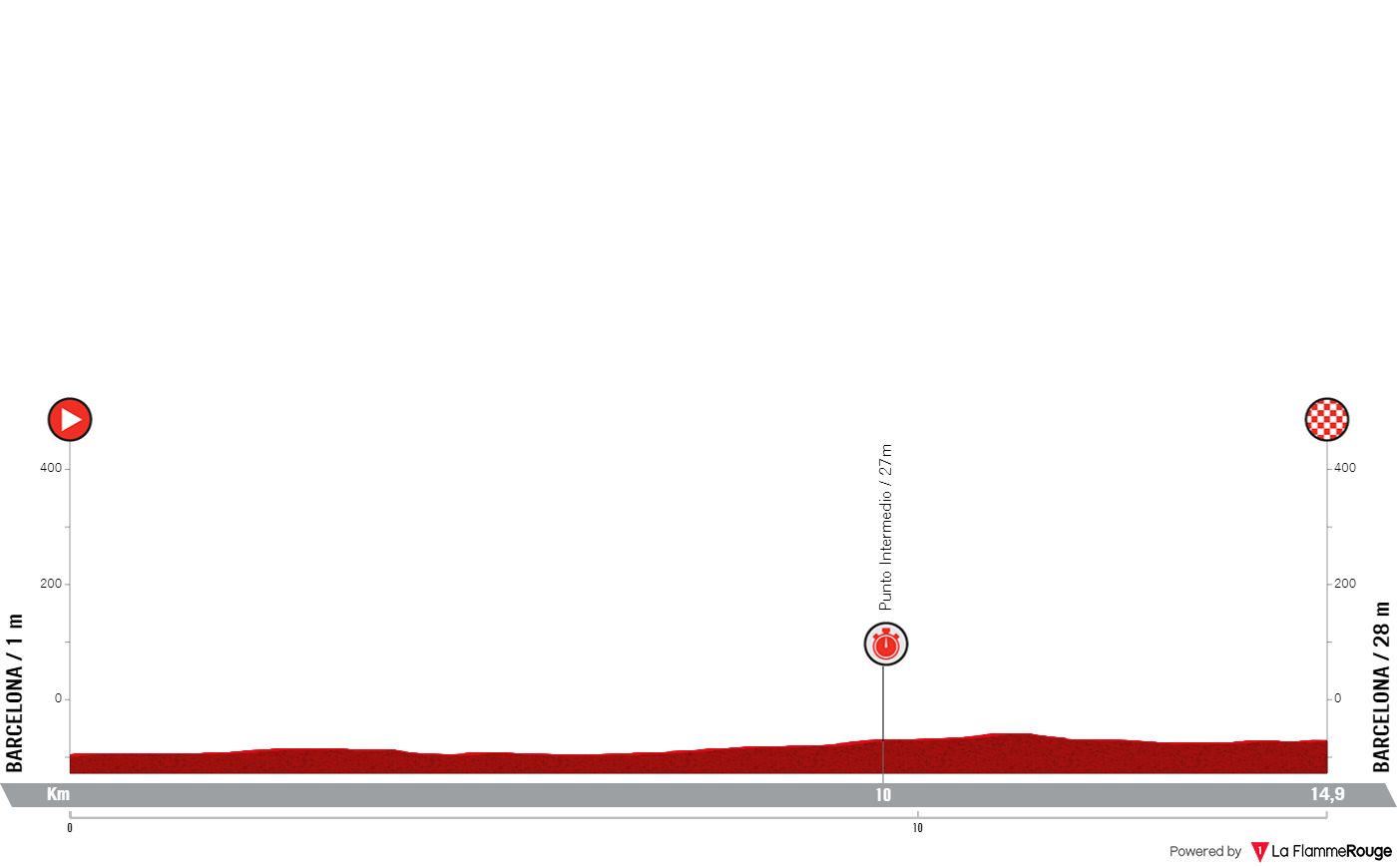
The race will start with a 14.9-kilometer long team time-trial in Barcelona starting at the Olympic port. It will create some small differences and make for a spectacular start to the race in the capital of the Catalunya region.
Play along with our Fantasy Vuelta a España 2023. At least $28,000/€25,000/£21,000 in prizes! Click here to create your own Fantasy Vuelta a España team.
It is a day that will be showing the best out of the city and will be a slightly technical day. There will be 18 corners of 90 degrees or around that, it makes for an unusually technical and explosive team time-trial, not the typical powerhouse-suited but one where riding in the wheels will be harder than usual.
This will make for a difficult run for whoever sets foot on the start line. The opening minutes specially will be technical, riders will need to be wary not to crash, as then in the second half there will be longer straights where the specialists will be able to put their power down better.
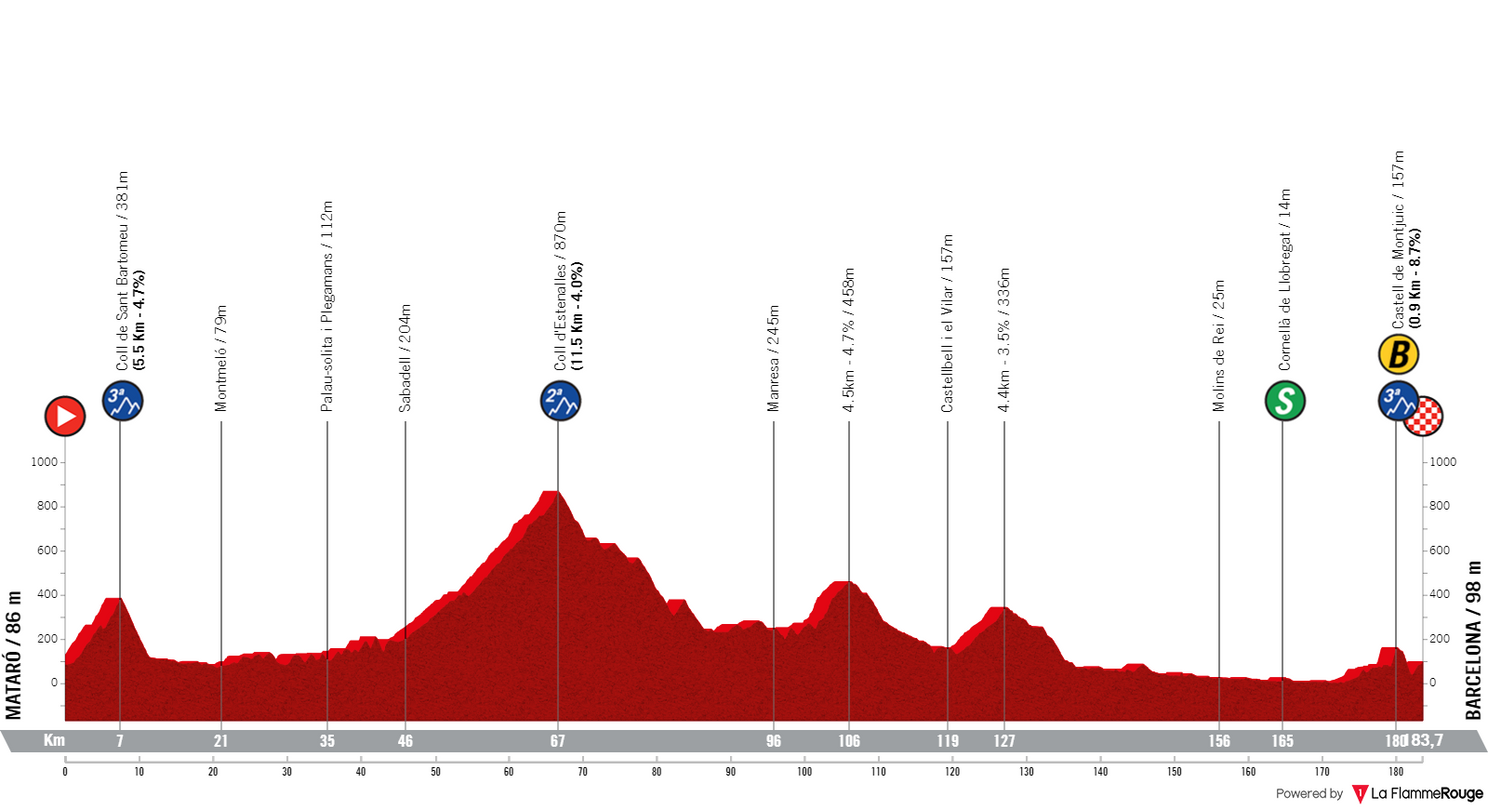
Stage two will be similar to that of the 2012 stage where Philippe Gilbert and Joaquim Rodriguez blasted away from the peloton. It's a hilly day, however not overly hard. The challenges will come as the riders return to Barcelona and will face the short but explosive hilltop of the Alto de Montjuic. The stage will end right after by the Olympic stadium.
There is an uphill start and by all means, the first two thirds of the day are quite hilly and later in the race it would be a day suited to a breakaway. But here it's unlikely, a red jersey will be on the line but plenty teams will seek it, the run-up to Barcelona is flat and allows for big gap cutting from the peloton, and besides the final kilometers, the run-up to Montjuic is certain
The climb is very sharp. Lately the Volta a Catalunya has returned to this vertent, it's 900 meters at 8.7% but it's gradients go as high as the double of that. It's an anaerobic effort, there won't be big splits at the summit but immediately the riders take on, with 3.7 kilometers to go until 1.5Km to go, a very fast and slightly technical descent where the gaps will grow in space (although not necessarily in time).
The race will momentarily solidify but immediately the riders hit the hilltop finale into the Olympic stadium. The gradients average 4/5%, it is not one for the sprinters even if some survive relatively close to the front, several of the climbers/puncheurs will benefit from the gradients. A late attack has quite good chances of surviving too.
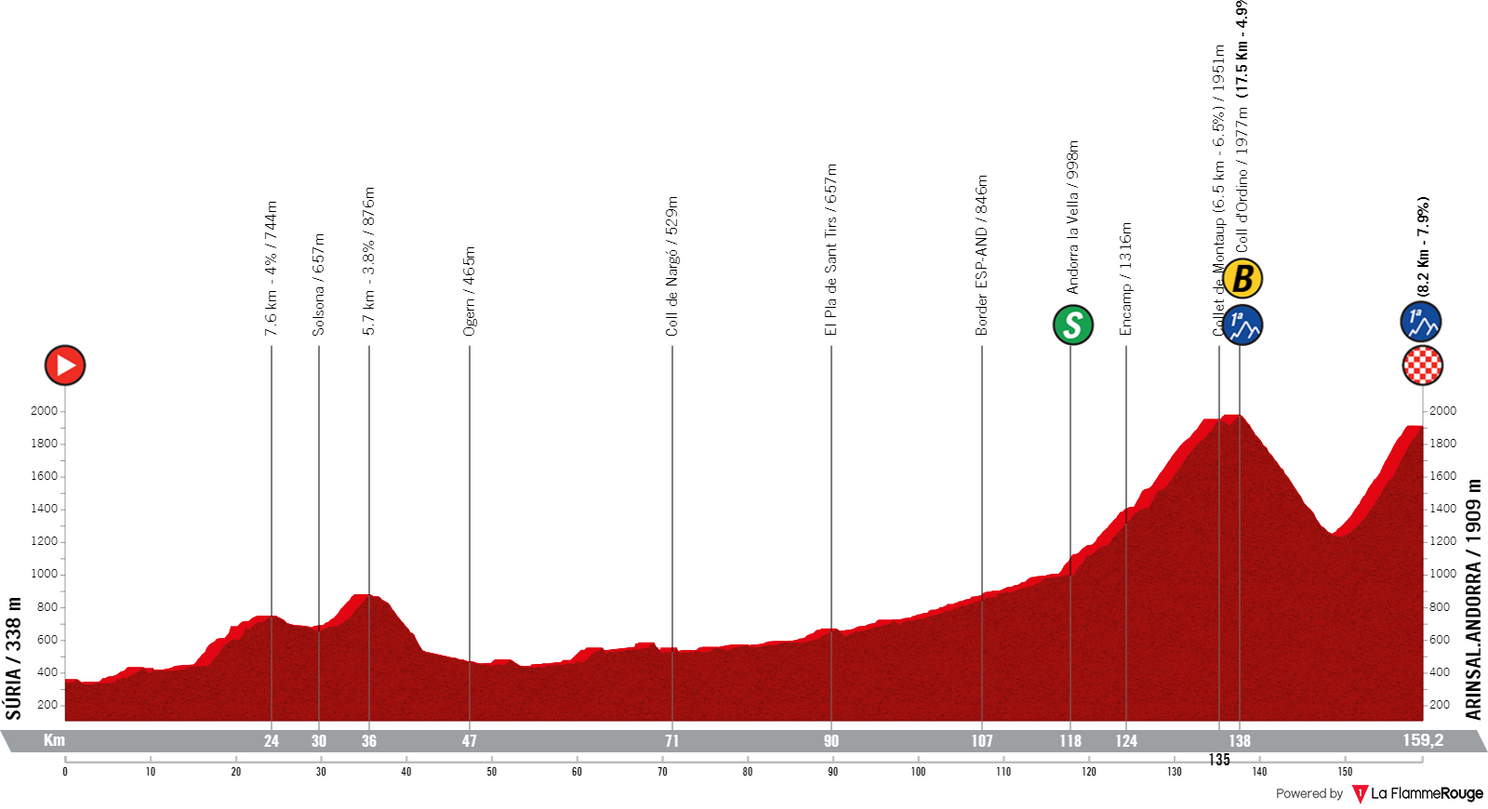
There is absolutely no time to settle in. Stage three will see the riders head north towards Andorra where they will find the first summit finish of the race. It is a high-mountain stage. After entering the microstate the riders will go up two ascents and finish in Arinsal where the first big selection should be made.
The stage starts in Spain, in Súria. The start is flat but after 20 kilometers the riders find some hilly terrain, there is potential for a breakaway with quality to go up the road. Most of the day is flat, straight, typical transitional. But then the riders cross the border to Andorra and the race changes. An intermediate sprint antecedes the first ascent.
This is the first category Coll d'Ordino, not climbed via it's traditional side. It's 17.5 kilometers at 4.9%, mostly a big ring climb, it will not create differences but will be a warm-up. At the summit there are bonifications, although it's unlikely that riders will be burning matches with the big climb that is still to follow. The summit comes with 21 kilometers to go and the descent is very technical, almost straight into the base of the final climb.
The riders pass the town of Arinsal and then climb towards the summit finish. The climb is 8.3 kilometers long at 7.6%. The first half straightforward, the final kilometers slightly steeper and with several switchbacks. This is a climb where attacks can come towards the end, and riders will enter the ascent relatively fresh, it's not necessarily a day to take it at pace.
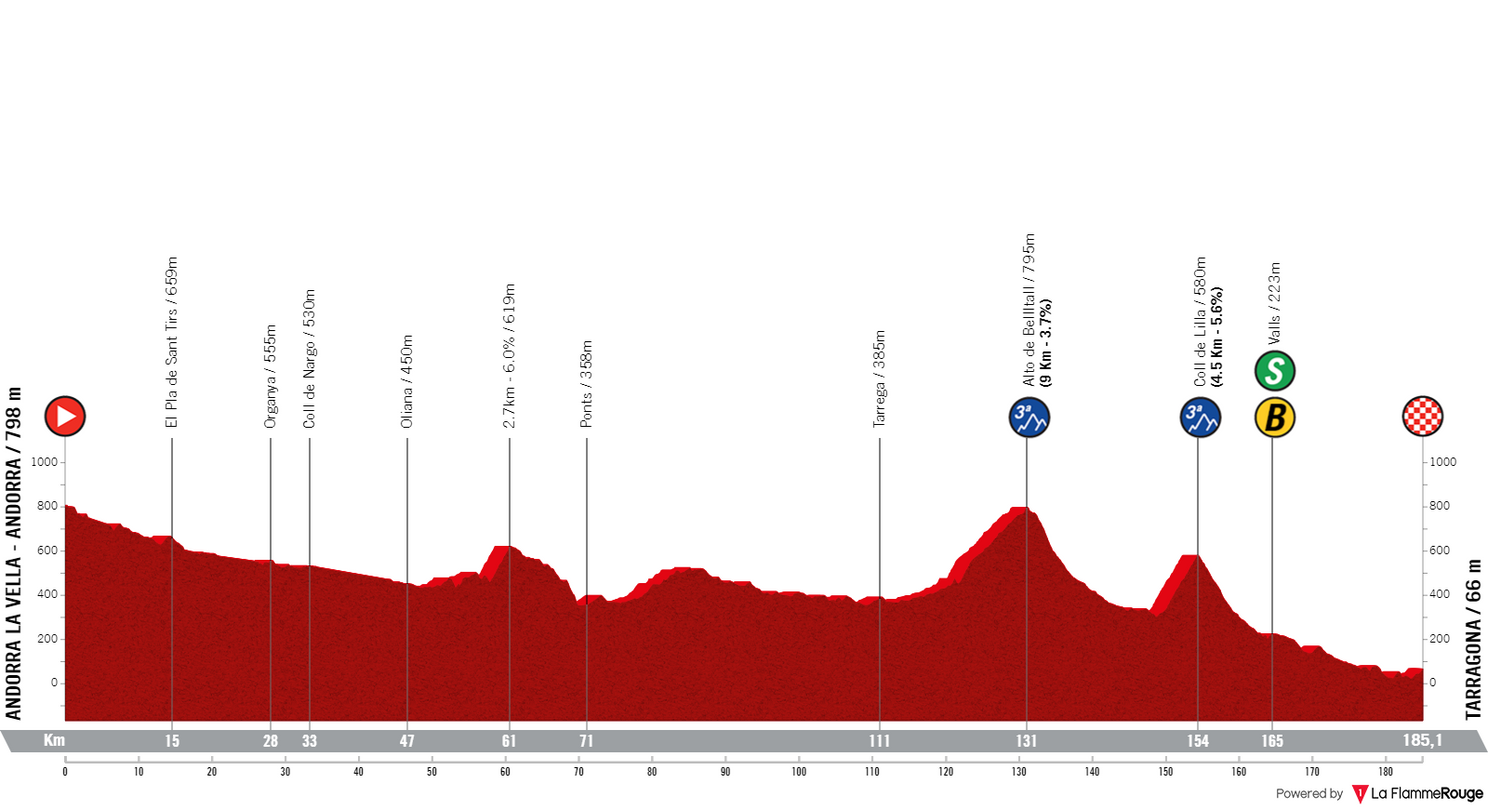
On the fourth day of racing however the riders return to the coast. It will be a fast ride back into Tarragona near Barcelona, with the route having a slight downhill tilt, however with a couple of hilltops towards the finish that won't make life easy for the sprinters.
The start is in fact mostly in a slight downhill. The riders depart from 798 meters of altitude and arrive at 66, there is a small hilltop after 60 kilometers of racing but until then the race will be set. The riders then find two categorized ascents. 9Km at 3.7% with 54 kilometers to go, then 4.5Km at 5.6% with 31 kilometers to go. The last one is not an easy one, and taking into consideration the mostly downhill finale afterwards some teams could ally to permanently drop a few sprinters.
Most likely however bullets will be saved for the run-up to the finish. There the finale is relatively simple until the final kilometers. A couple of roundabouts, then with 1.7km to 900 meters to go the road rises slightly. The peloton finds a turn with just under 500 meters to go which will be crucial, from there on the riders have an uphill drag to the line with around 5% average, not one for the pure sprinters, it will be an interesting finale.
Also read
PREVIEW | Vuelta a Espana 2023 stage 4 - Kaden Groves man to beat in race's first bunch sprint
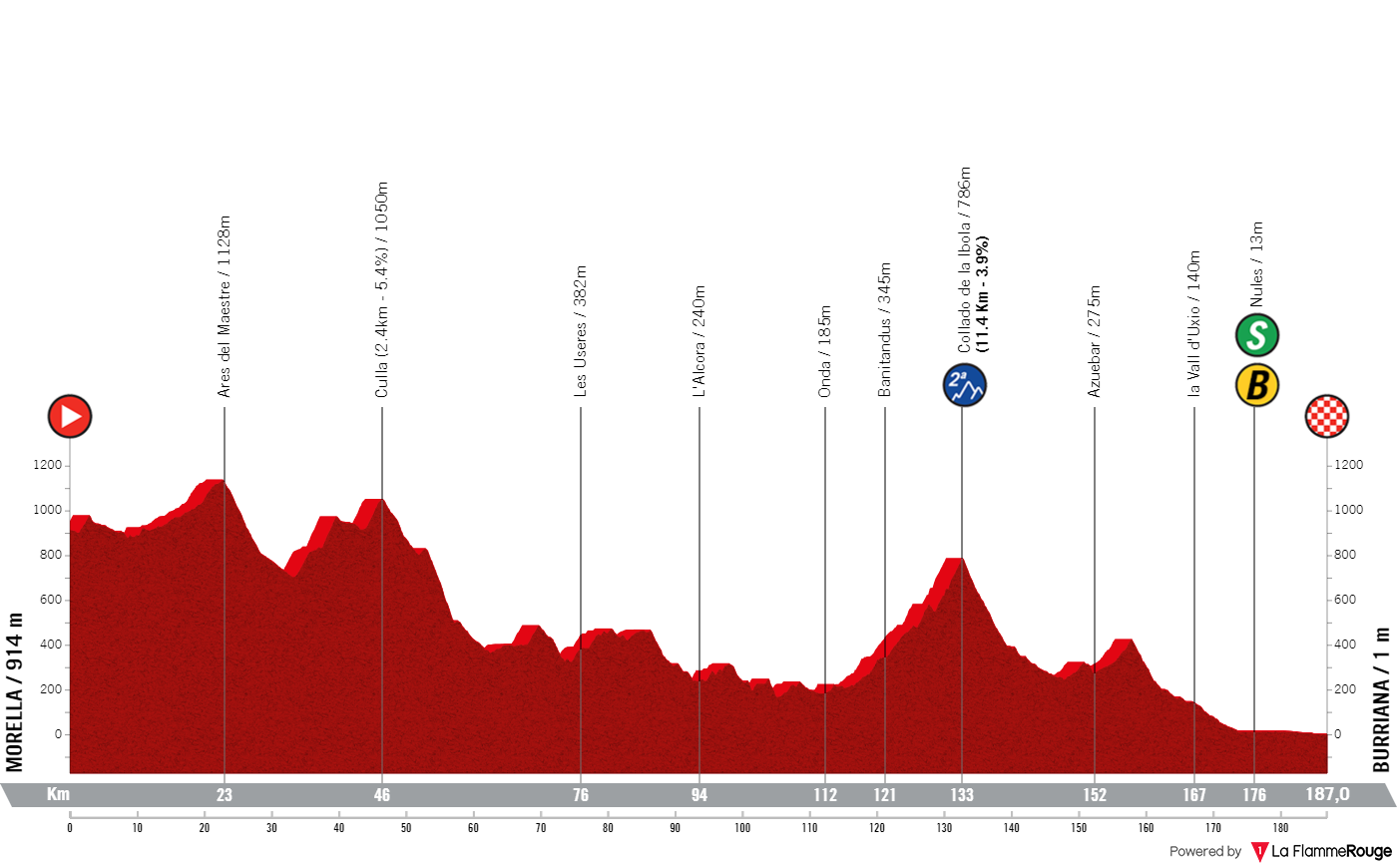
Stage five from Morella to Burriana is a tricky one. A day for the sprinters on paper however, as is classic at the Vuelta a Espana, it features the 'rompe-piernas' terrain which will throughout the day benefit attackers and make the pure fast men suffer in the small but repetitive climbs.
If a bunch sprint is to take place a breakaway can only be given a very small leadout throughout the entire day. The start is at 914 meters of altitude and then end at sea level, so there's a lot of descending terrain, but equally there are many small ascents where bringing back gaps is a tough task. The start has uphill ramps and the pan-flat roads only really come with 15 kilometers to go. It's a difficult one to control.
However, assuming it does come back and a bunch sprint happens, it will be a very fast one. A few roundabouts in the town of Burriana, from 2.8km to 800 meters to go there is a flat straight, and then the finishing straight are those final 800 meters, pan-flat and straightforward with no obstacles, but right by the sea where the wind can make a difference.
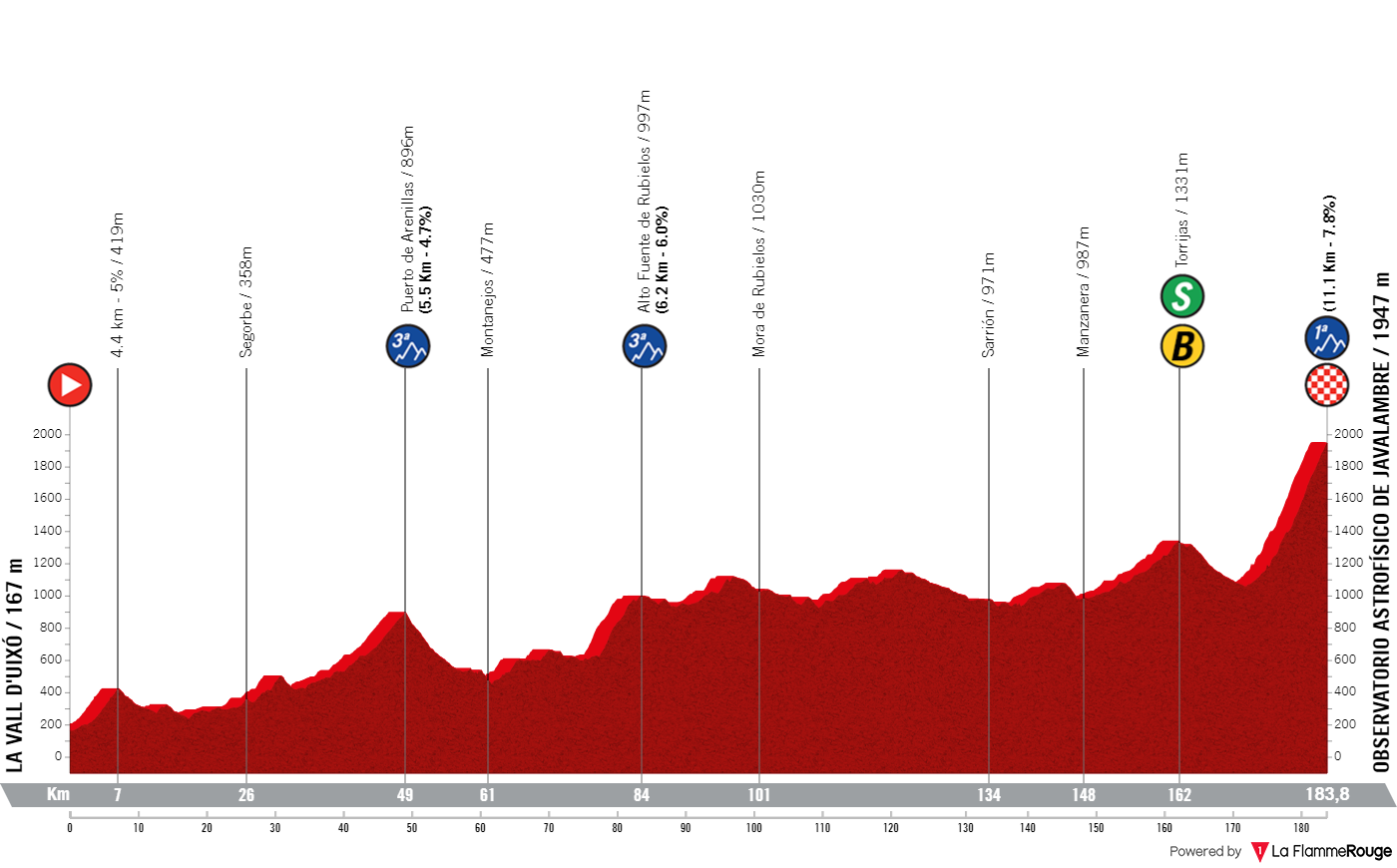
On the sixth day of racing the riders ride into a familiar sight for the second summit finish of the race. It will be at the Observatorio Astrofisico de Javalambre where the finish line will be positioned, with it's 12 kilometers at 7% providing terrain for differences to be made amongst the GC men. It's a day that is seemingly almost flat until the final climb but that's incredibly far from reality.
The riders start off which a 4.4-kilometer climb at 5%, and then they find several similar to that throughout the day. The 183 kilometers see only three categorized climbs, only one meaningful ascent, but it has 4000 meters of climbing. By no means will the riders arrive fresh to the ascent of the Observatorio Astrofísico de Javalambre.
The ascent is 11.1 kilometers at 7.5%. Completely exposed to the sun, and wind if it's present, it's a tough ascent. The gradients are relatively constant in it's final kilometers between 8-11%, the start is relatively calm but with the fight for positioning the pace will be high. This is a stage that has Vuelta written all over, it will also be an important day for the overall classification, and one that forces the GC riders to be at their best early on.
Also read
PREVIEW | Vuelta a Espana 2023 stage 6 - Javalambre climb the first test for Remco Evenepoel in red
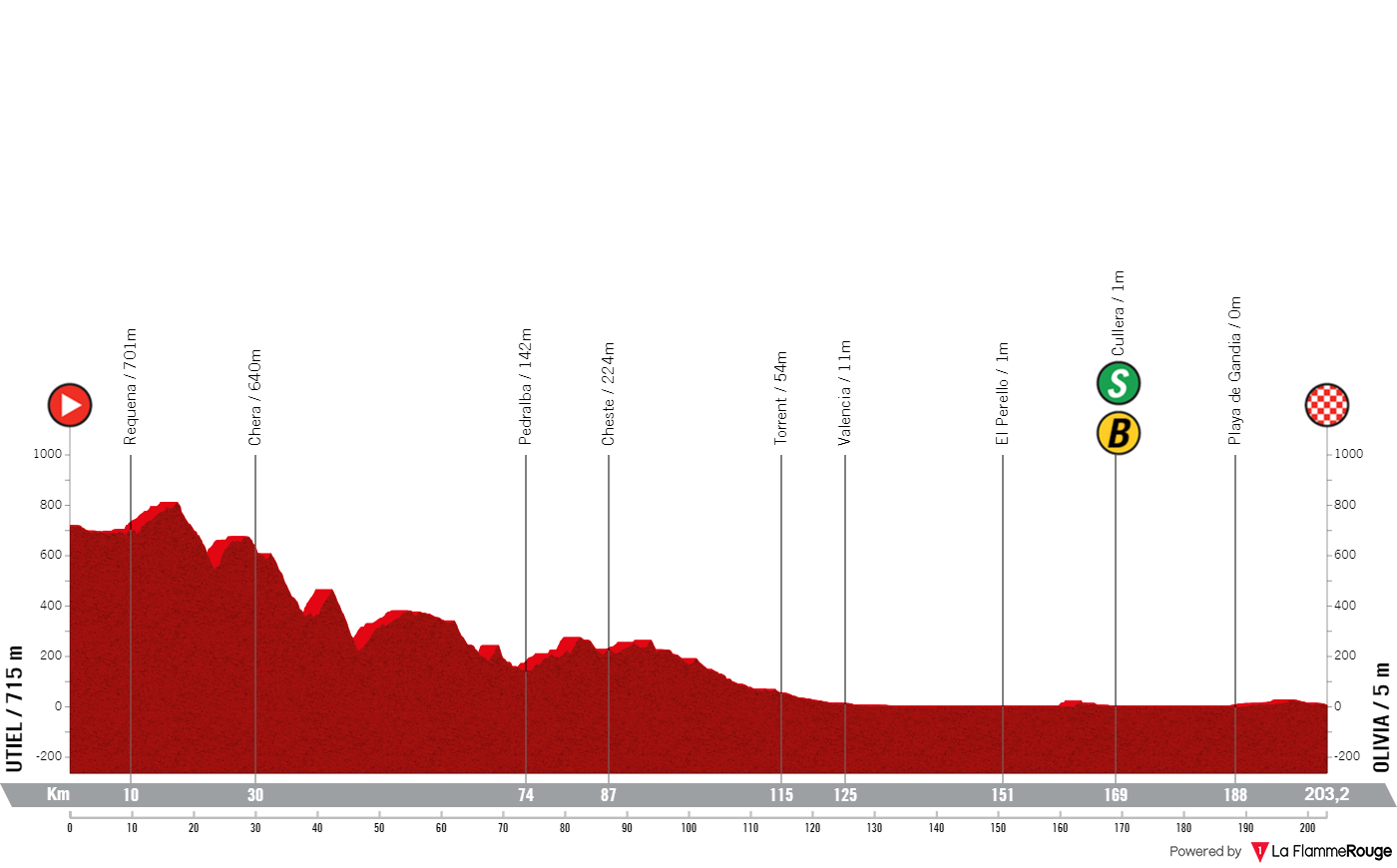
Stage seven will be a good sight for the peloton who find a flat stage. The first half of the day will largely be downhill which means the peloton can't afford to give the breakaway much of a gap, but the run-in to Oliva will be pan-flat.
However it's another day which finishes at significantly lower altitude than the start, 700 meters, which means fast speeds which favors breakaway. The opening half of the stage will be quite hilly in fact, featuring no categorized climb but plenty small hilltops where some fatigue will be created. However the second half of the day should be gentle enough to keep things under control.
It is most likely a day for a bunch sprint, through roads the peloton will know very well. The riders pass through the outside of Gandia and then finish very close to the area where dozens of teams train throughout the winter. In the town of Olivia is where the finish line will be, not an overly technical finale but a nervous one. The final corner will come with 350 meters to go and there will certainly be a sprint towards that, and then a second sprint towards the line.
Also read
PREVIEW | Vuelta a Espana 2023 stage 7 - Will Filippo Ganna win his first World Tour bunch sprint?
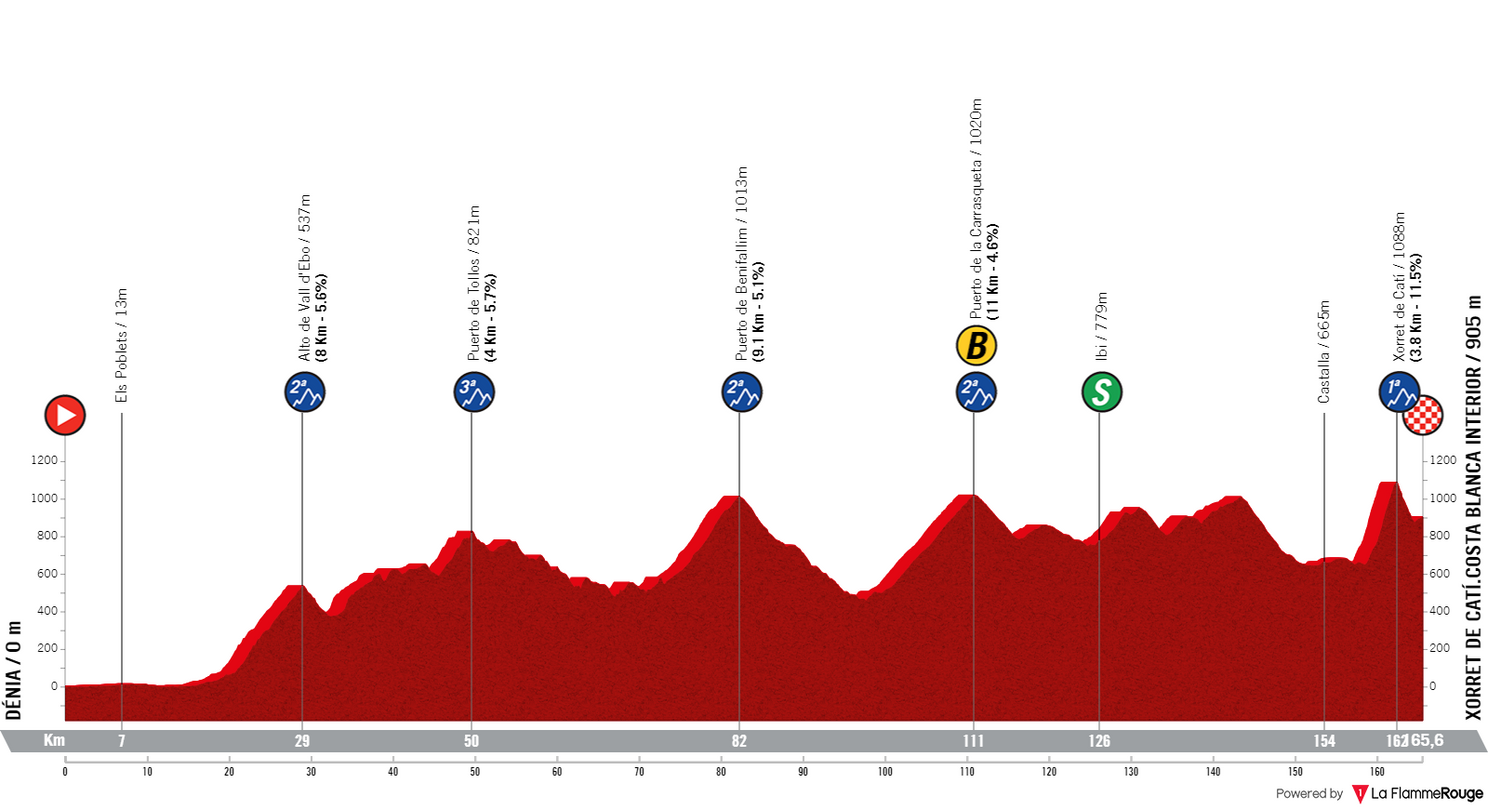
In cycling country, the riders set off from Dénia where many had their team training camps early in the year. However what follows is certainly harder, with five categorized climbs and many more en route to Xorret de Catí, where the steep gradients will see further damage done in the GC fight.
Another day without any brutal ascent before the finale but absolutely packed with climbing. Over 3600 meters of climbing with four categorized ascents in the first two thirds of the day, and plenty more uncategorized. The first 20 kilometers of the day are flat however, not ideal for the breakaway opportunists. The longest ascent of the day will have bonus seconds attributed at it's summit, the 11.1-kilometer Puerto de la Carrasqueta summits with 54 kilometers to go and averages 4.6%.
From there on follow rolling roads, several small hilltops where, if it's in the breakaway, the fight for the stage win will certainly explode as riders look to anticipate the final ascent. That one is a well known feature in the Vuelta, that is the incredibly steep Xorret de Catí.
The climb is 3.8 kilometers at 11.4%, but it's a mean climb in every aspect. It slowly steepens until it reaches 15% and then the riders face several minutes of racing at that gradient. There is no moment of restbite and not a single switchback in the ascent, it's a pure W/Kg challenge up the short ascent which can create big differences. The summit is at 3.6 kilometers to go, following is a very fast steep descent and the final 900 meters which slightly rise to the line.
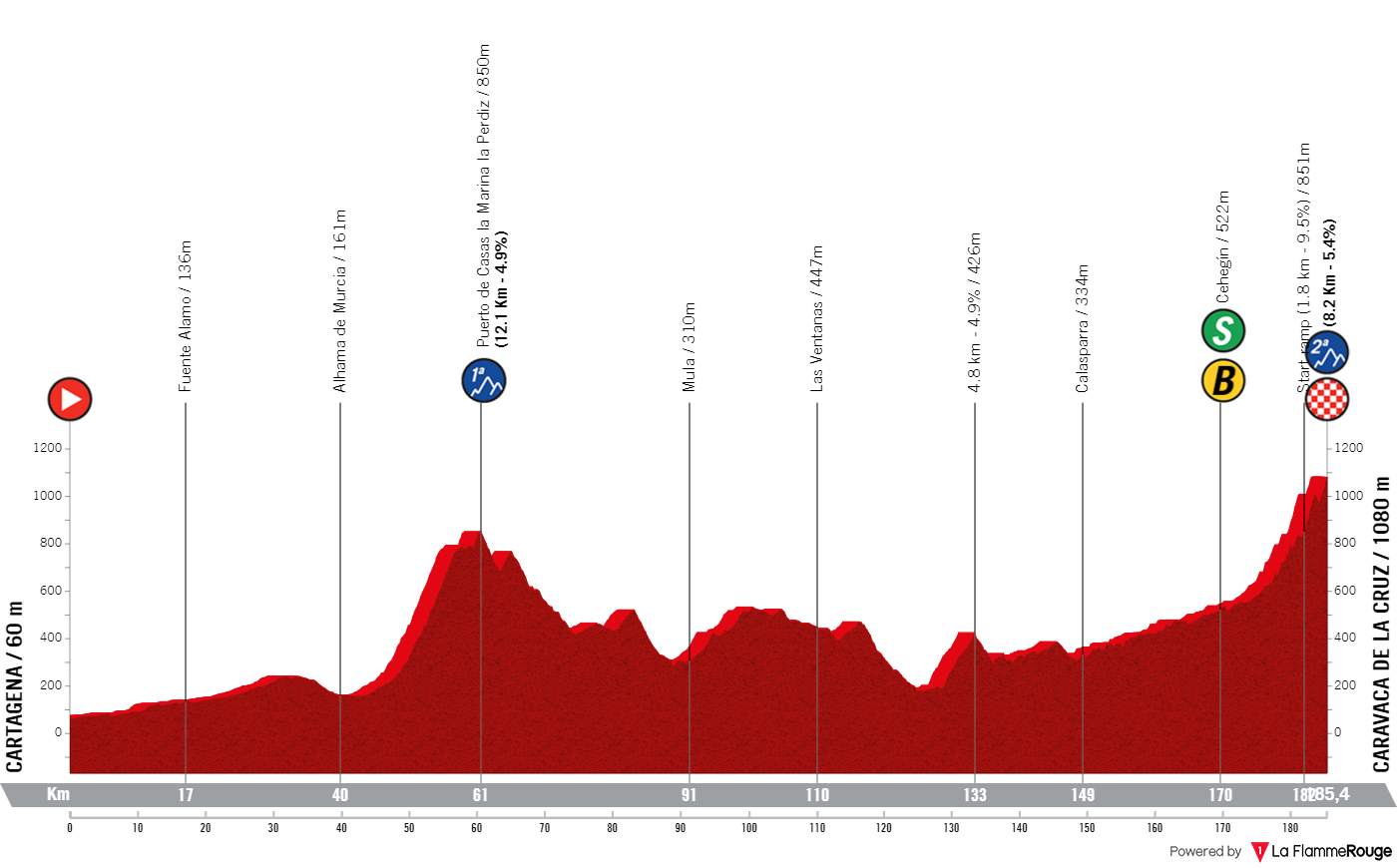
Stage nine, the final day of the first week, doesn't show any mercy for those who dislike climbing. It is a hilly stage, likely one for the breakaway, as the riders tackle an interesting finale in Caravaca de la Cruz. An interesting day, a classic Vuelta stage I would say, the profile is very unusual and the final climb is as inconsistent as they come.
After a flat start the riders find the Puerto de Casas la Marina la Perdiz. It is 12.1 kilometers at 4.9%, however it does feature a small descent close to the summit. It is still very far away from the finish however, afterwards are a bunch of rolling hills and a plateau ride into the town of Caravaca de la Cruz. The finish is in the hills surrounding the town, an ascent that is something special.
The climb is 8.1 kilometers at 5.4% but the average doesn't tell the story. There are five small descent or flat sections spread all throughout the ascent. It is essentially a combination of ramps, on twisty explosive roads. Most riders will eye the final 3.5Km, the gradients will rise as high at 17%, and then the final kilometer averages close to 8%. It's not a climb that the riders will be able to ride at pace, it's a very difficult effort which can prove to be very complicated to manage for some.
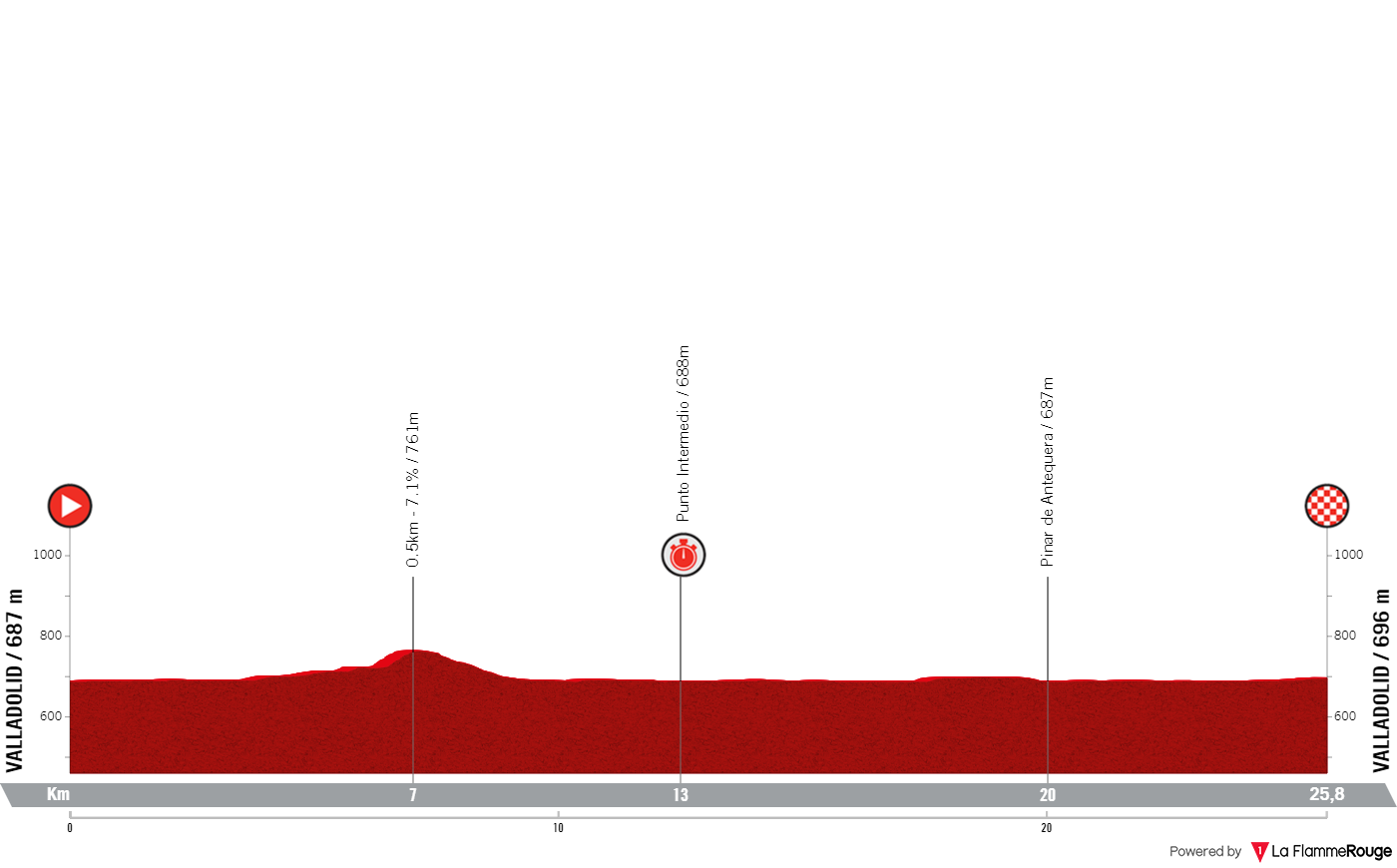
The riders head into the second week of racing with the only individual time-trial of the race taking place. This will be in the city of Valladolid where the 25 kilometers against the clock will be a key challenge for those eyeing the red jersey.
This is an interesting time-trial when looking at the map. Profile wise it's virtually pan-flat, it does feature a small 500-meter long ramp early on but it's not what will be changing the outcome of the stage. When looking at the map you realize that the whole time-trial is within the city, all 25 kilometers of it, as the organizers drew a route which in it's first third rides around the same spot virtually but back and forth through some roads.
This won't make a change in the type of rider who can fight for the victory, but is an interesting aspect. The second half is almost completely an out-and-back time-trial, using the same avenue but in different directions. The riders will get the sense that they're racing around the same location throughout the whole time-trial but the distance allows for there to be meaningful gaps at the finish.
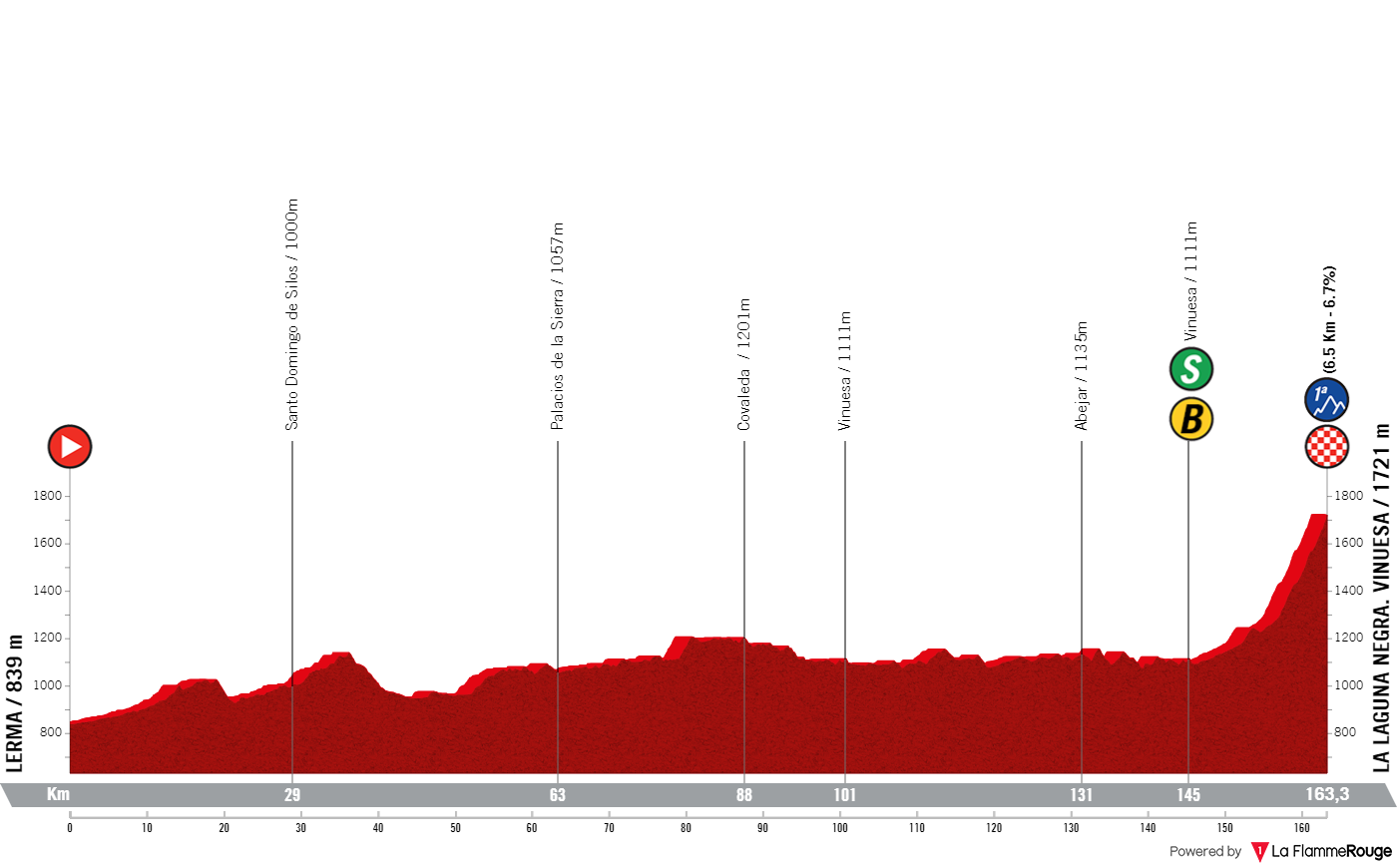
Very similar to the ninth day of racing, stage 11 is a complicated day due mostly due to it's finale. It's a stage that features little climbing but has a slight summit finish. This time in Burgos at La Laguna Negra, it's an explosive finale where several can contest the win.
163 kilometers on the menu and honestly not really much to mention. Virtually the entire day is flat, with small ascents as is always the case on Spanish roads, but no intermediate sprints, KOM points or anything too special. Then it heats up towards the finale, the organizers have put in yet another summit finish where the climbers will have to go to the limit.
It's not an overly hard climb, 6.6 kilometers at 6.6%. The speeds will be very high, the riders will enter fresh, so I expect a lot of slipstreaming and the lack of aggressive racing. The steepest section of the ascent will exactly be it's end, the final 500 meters have the road go at around 10%, it's most likely a stage to ride in the wheels and then fight for seconds in an anaerobic final kilometer.
Also read
PREVIEW | Vuelta a Espana 2023 stage 11 - Fireworks or GC stalemate as Laguna Negra de Vinuesa?
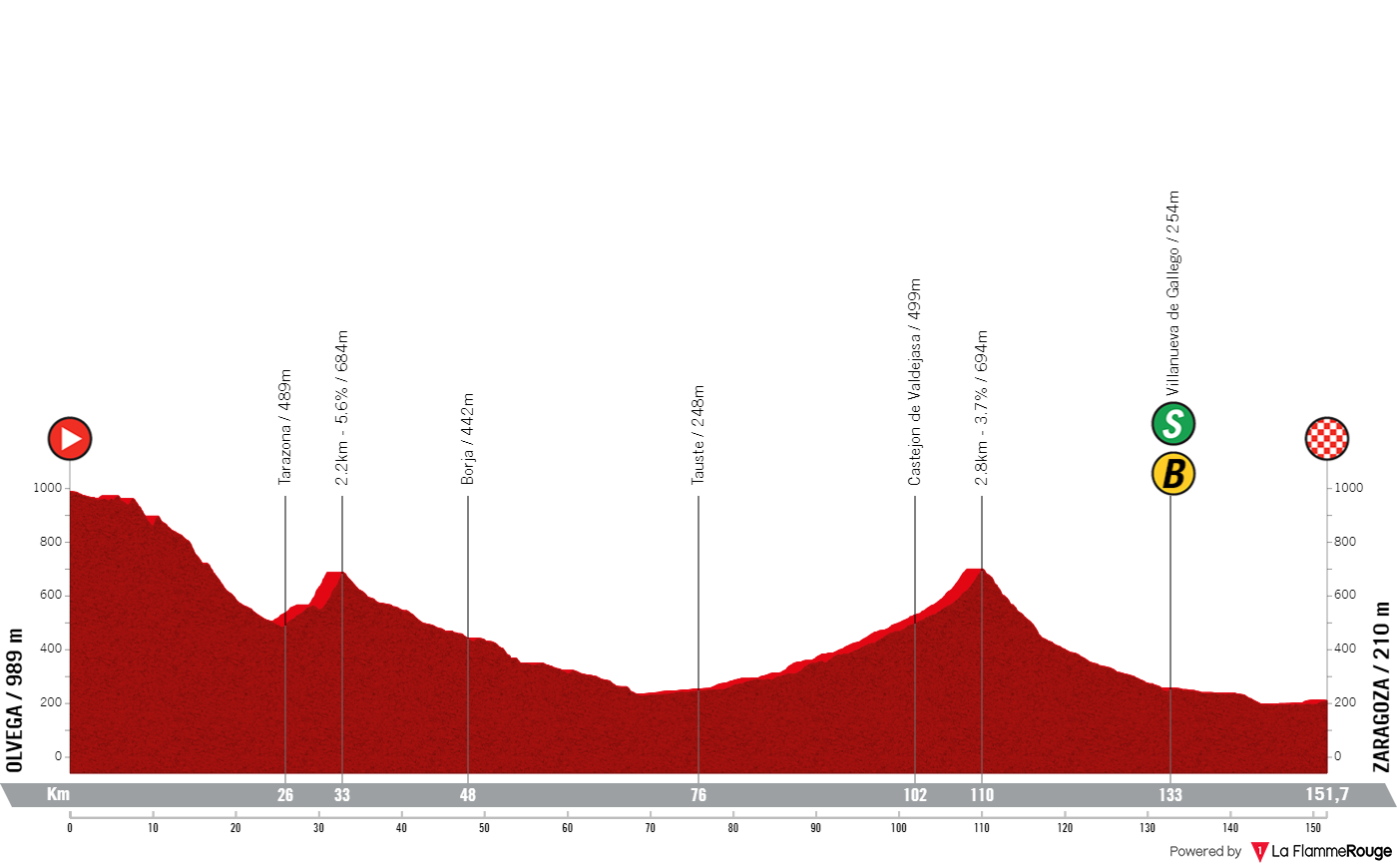
Stage 12 will be one of the brief but valuable opportunities for the pure sprinters. The day sees the riders go through 151 kilometers eastwards towards Zaragoza for a virtually inevitable bunch sprint. A seeming tradition in this year's route, the start line is at 989 meters of altitude and the finish at 210, so overall a downhill profile to the day.
However on this day there is very little to report, there are few obstacles for the fast men. A small hilltop after around 33 kilometers and another after 110. These won't be true climbs however, only the wind can cause difficulties on a day like this for a Grand Tour peloton.
However the riders will find an urban sprint. Entering Zaragoza, they then face a ride through the city, not overly technical but road furniture, section where the road width changes are always present. The main point to take into consideration will be the corner with 1.3 kilometers to go which is the final one, but from there on there is still space to regain position, the finale is flat and without anything unusual.
Also read
PREVIEW | Vuelta a Espana 2023 stage 12 - Before the high mountains, a return to the bunch sprint
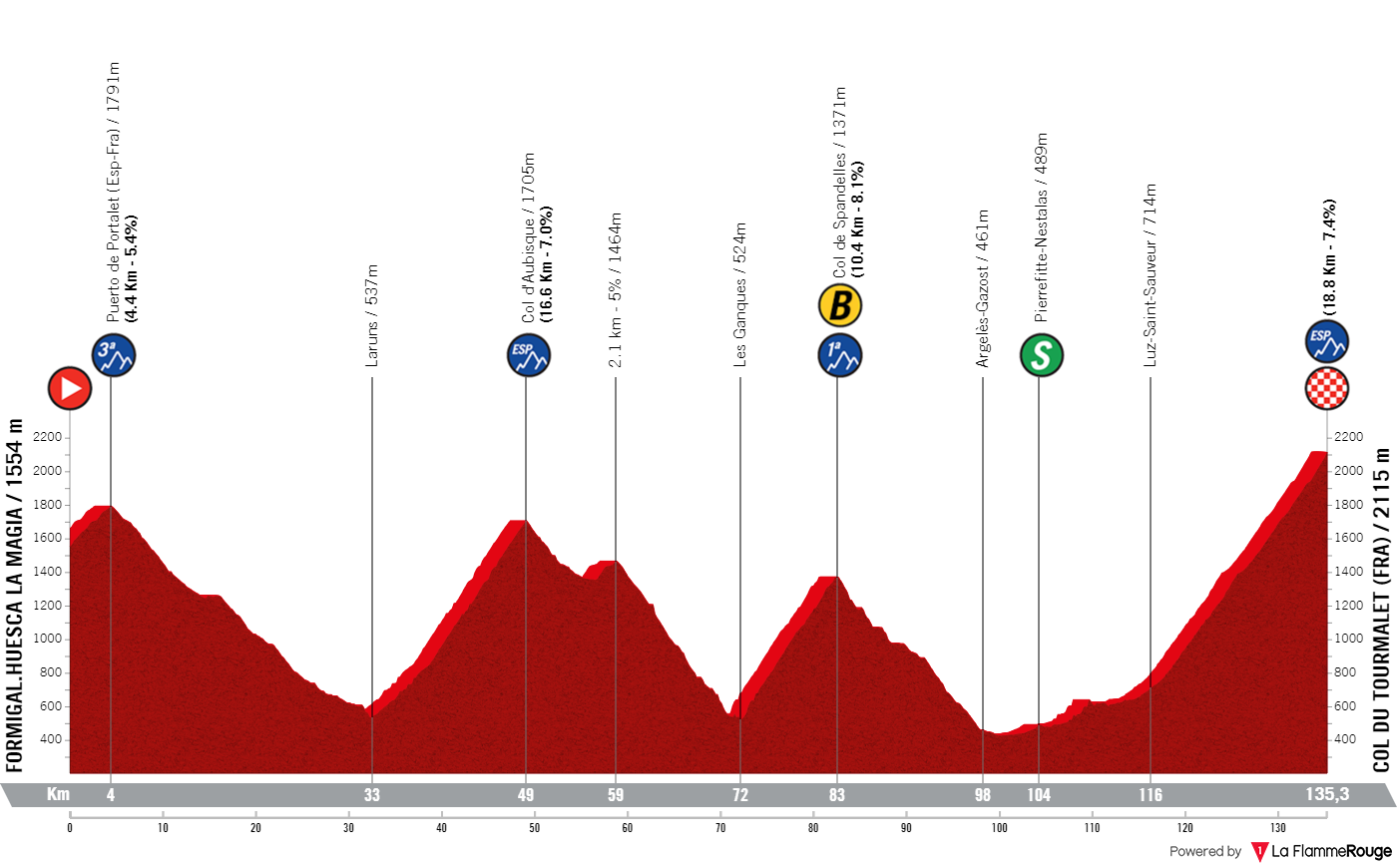
The queen stage? Some were queen to call it that. Stage 13 was one that had been highly rumoured and turned out to be exactly as expected as the race heads into the Pyrenees, with a mammoth mountain stage. Not by size, as it extends over only 134 kilometers, but they are constantly up and down. The riders will go up the Col d'Aubisque and Col de Spandelles which individually are both very hard ascents, before the summit finish at the Col du Tourmalet above 2000 meters of altitude.
The stage immediately starts off climbing with the Puerto de Portalet, 4.4Km at 5.4%. A long descent follows, and then the serious climbing will begin. Almost immediately in fact, it is the famous Col d'Aubisque, one of the longest and toughest ascents of the Pyrenees, on this day only the first of three very difficult climbs. It is 16.6 kilometers long and a constant ascent averaging 7% which summits with 86 kilometers to go.
A descent follows which leads the riders at the base of the Col de Spandelles. This was a climb that saw plenty action in the final mountain stage of the 2022 Tour de France. Here it's unlikely to see the same type of move, however the potential is there. At it's summit there are still 52 kilometers to the finish, but with over 10 kilometers at 8% and packed with switchbacks, it can see the race break apart.
After it's descent comes the one real flat section of the day, however it is not too long. The riders gradually begin to climb into Luz-Saint-Sauveur, the base of the Tourmalet. 18.7 kilometers at 7.4%, very constant and with it's summit at 2115 meters. This is a day, and a final climb suited to the pure climbers. No getting out of it, it's a day that can see very big differences and the first of two key days in the Pyrenees.
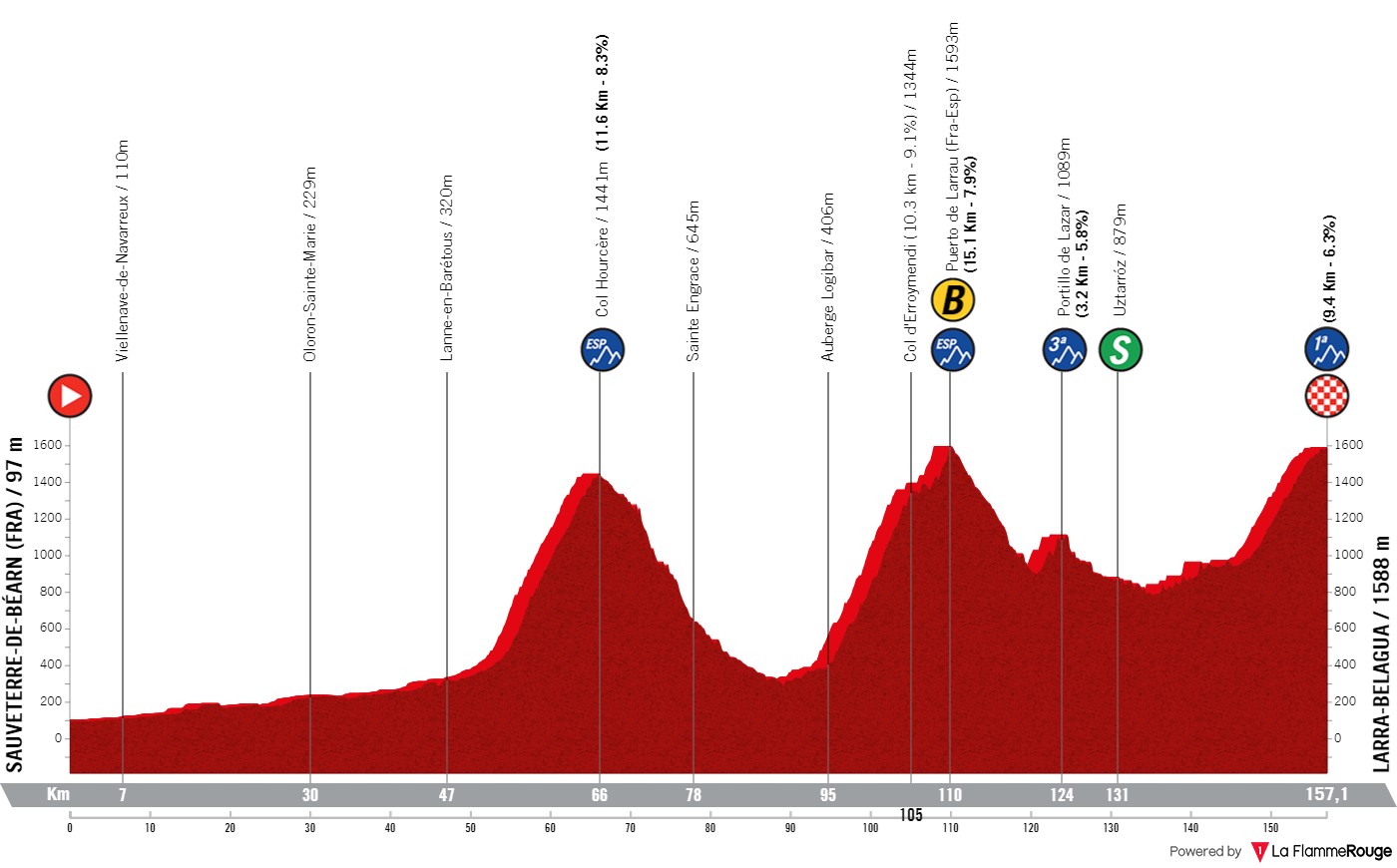
The peloton will leave the Pyrenees, but not before another incredibly hard mountain challenge. Stage 14 from Sauvaterre-de-Béarn and Belagua will feature the Col Hourciére and the Port de Larrau in quick succession, both HC category climbs into the Spanish border. The stage will still see a first category summit finish at Belagua to wrap a very hard day.
If raced aggressively, this could end up being the queen stage. As is usually the case at the Tour de France however, the organizers decided to go with a flat start. This will not be good for the climbers looking to form a breakaway, it can end up limiting the tactical moves from the bigger teams. However after 50 kilometers of riding the mountains arrive.
The first of which is the Col Hourcère, it's 11.6 kilometers at 8.3%, in terms of profile incredibly similar to the Alpe d'Huez, coincidentally it also features plenty switchbacks. It summits with 91 kilometers to go however it's hard enough for any kind of attack that teams may plan.
The descent comes and leads the riders right to the base of the next climb, so there is very little time to reorganize. The Puerto de Larrau will follow quickly after, it's 15 kilometers long at 7.9% but is even harder than the average suggests. It's first 10 kilometers average over 9%, it's another brutal climb, two in a row will make it a very difficult mission.
There is a steep punch to it's summit which comes with 47 kilometers to go. The descent will now not be as long, in fact only a few kilometers long before reaching the third climb of the day, the easy by comparison Portillo de Lazar which summits with 33 kilometers to go, it's 3.2 kilometers at 5.8%.
Then there is a transition phase until the final climb. The riders have entered Spain but will come to the literal border with France once again. The climb to Belagua won't be as hard as the previous ones, however with the fatigue built up it can certainly be as dangerous. It's 9.4 kilometers long at 6.3%, it's final kilometer almost flat, most of the climb hence being a little steeper than the average. It is a climb that features plenty switchbacks, so the constant gradients don't mean that it's a hard place to attack.
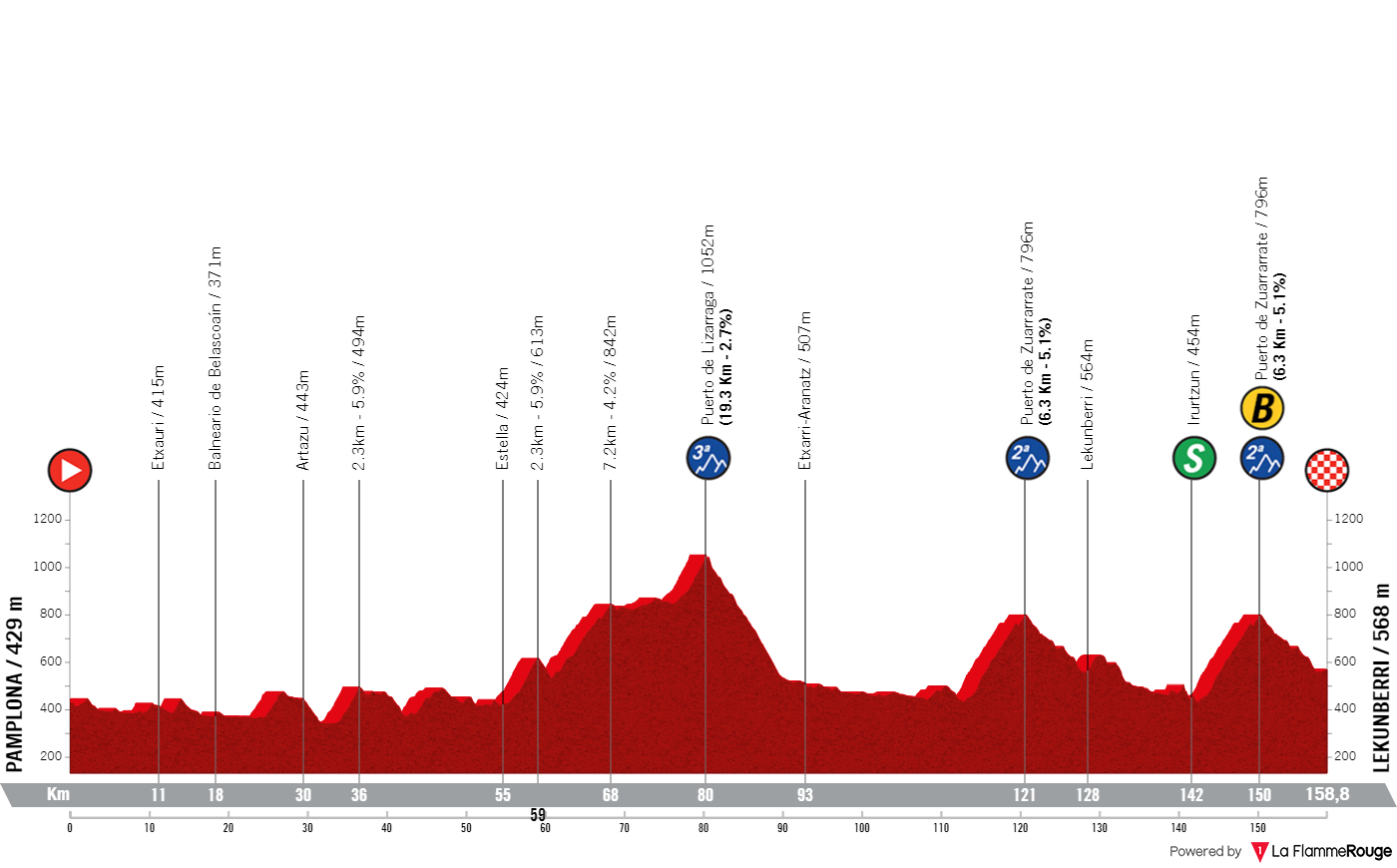
Stage 15 will be a hilly and explosive day, fit for the puncheurs and classics riders. The finale will be in Lekunberri after the riders take on the double ascent of the Puerto de Zuarrarrate. The riders will be happy to leave the high mountains however they must be fully focused for a day that features quite a few traps.
A technical and bumpy start is golden territory for a quality breakaway to form. This can see GC riders try out their luck in a day where GC teams want to save their legs most likely, but it's also prone to split which can be equally as dangerous. When it comes to the fight for the stage win - and GC battle, if it takes place - it will come down to the final circuit, in and around Lekunberri.
The riders will on two occasions climb the Puerto de Zuarrarrate which is 6.3 kilometers at 5.1%. Plenty riders can soar up an ascent such as this, it's a very open day. It summits with 38 and 9 kilometers to go, the descent is fast and straightfoward. Up the final ascent, if a rider goes solo over the summit it'll be near impossible to be brought back.
Also read
PREVIEW | Vuelta a Espana 2023 stage 15 - Breakaway day the end of an explosive second week
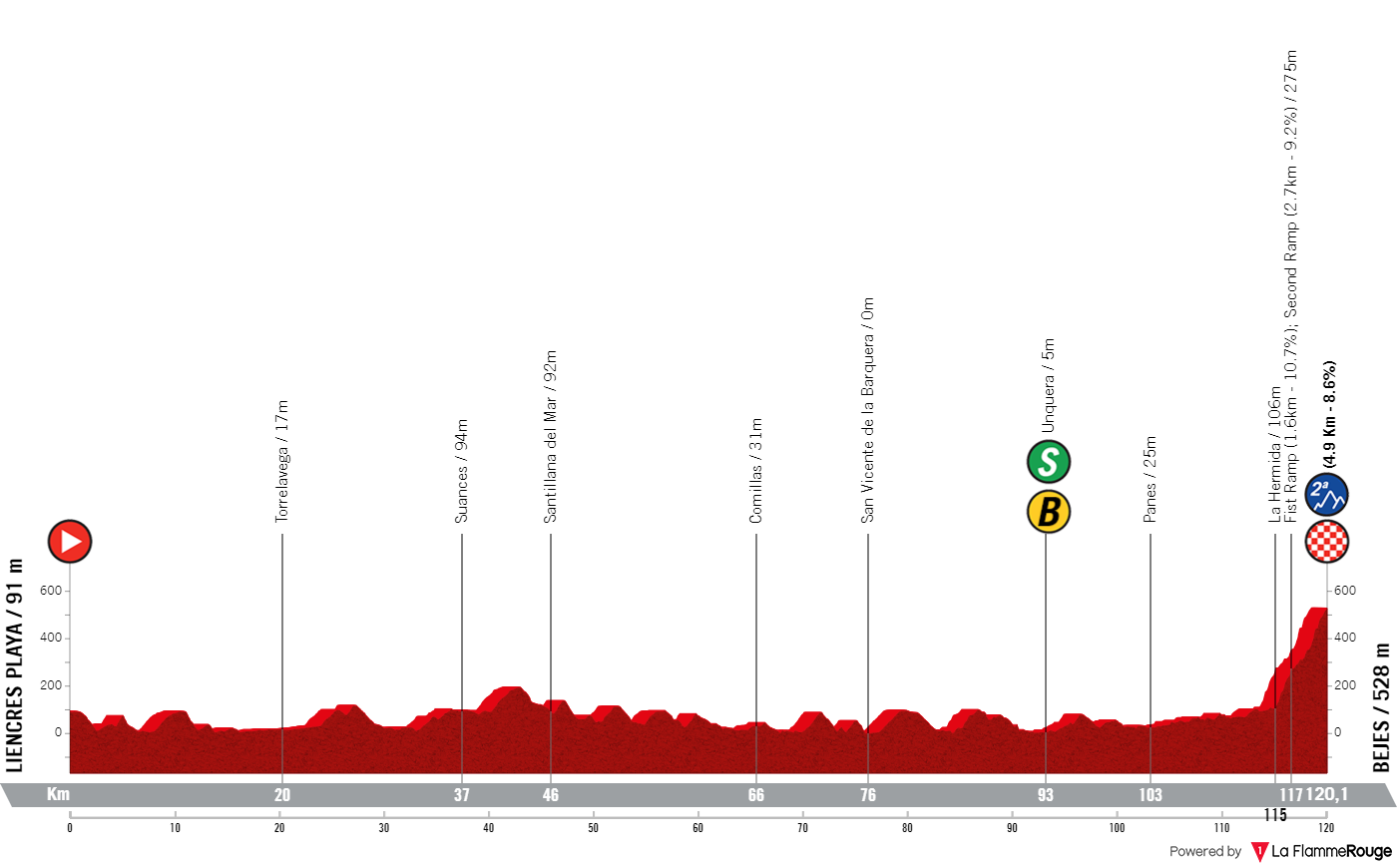
Stage 16 will be a very short day through the rugged Spanish north, with a brutal summit finish. It is a very untraditional stage format, but the day will be decided in the ascent to Bejes where the gradients will reach up often above 10% for almost five kilometers.
A truly remarkable day when it comes to how differently the organizers design stages. This, the first day of the final week, is almost designed to see incredible watts in the final ascent. Close to the sea, the race has 115 kilometers which are rolling but without any meaningful ascent. It's all about the final ascent to Bejes the day.
The finish will be just outside the scenic village. The climb is 4.9 kilometers at 8.7%, starting off very steep, having a bit of a flat section in it's middle, and then rolling along on gradients of mostly 10% all the way into the line. A grueling summit finish, it will make for interesting viewing, tactics won't matter much but instead it'll mostly be about the legs.
Also read
PREVIEW | Vuelta a Espana 2023 stage 16 - Sepp Kuss has lead tested in another tough summit finish
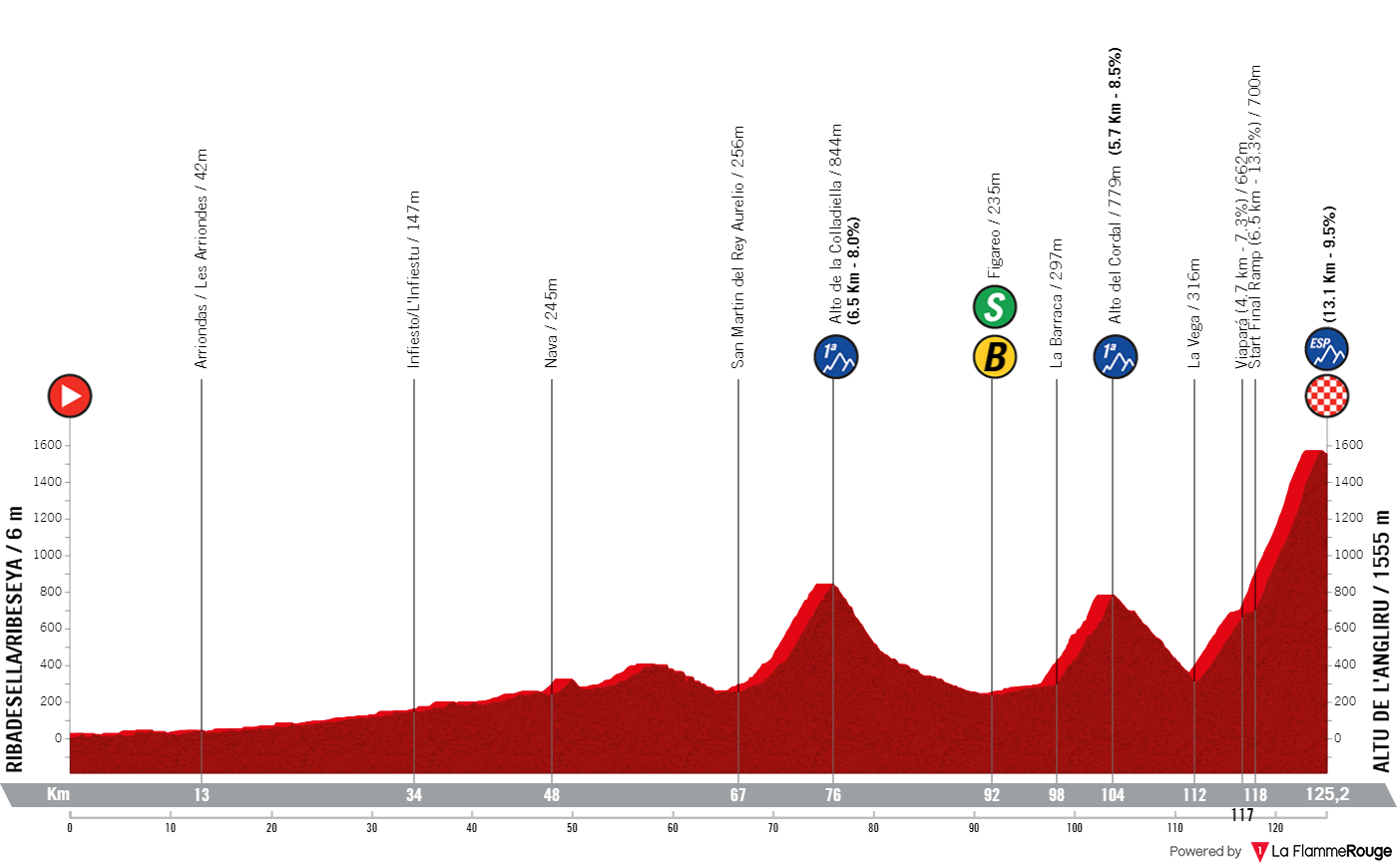
Stage 17 will be a brute, and an absolutely mythical day of climbing. The Asturian monster of 2023, the riders will be climbing the Alto de la Colladiella and the Alto der Cordal - both first category climbs - before directly riding up the Alto de l'Angliru for a summit finish. Almost 13 kilometers at 10% with several ramps over 20% will make for very large differences.
It is a very short day in terms of distance, 125 kilometers with a flat start - the Tour de France playbook was used once again. Ultimately it'll mean very little action to start off the day, it'll all be saved for the final half. The Alto de Colladiella will open things up with it's 6.5 kilometers at 8% finishing with 49 kilometers to go.
However the GC riders will begin to gauge their efforts more carefully afterwards. In 2017 Alberto Contador attacked in the Alto del Cordal, it's 5.7 kilometers at 8.5%, steep and with plenty switchbacks, the descent is exactly the same and leads to raiding territory. The only reason why it ends up being unlikely is because what comes next is a climb of breathtaking toughness.
From the base of the descent to the final climb. The mythical Angliru is 12.3 kilometers at 10%. The first half not too difficult, with some tough gradients but never above 10%, and it even includes a kilometer long flat section. What is brutal is what follows. 6.5 kilometers at 13.3%, with several sections where the gradients go above 20% - the steepest being the famous Cueña les Cabres at 23.5%.
It's just gruesome, there's very little that teammates can do here, it'll be down to the individual strength of the riders who try to get to the summit the fastest. Those behind will likely struggle just as much however. The summit of the climb is inside the final kilometer, the organizers place the finish line in a small descent after the peak.
Also read
PREVIEW | Vuelta a Espana 2023 stage 17 - Can Sepp Kuss seal the deal at the mythical Angliru?
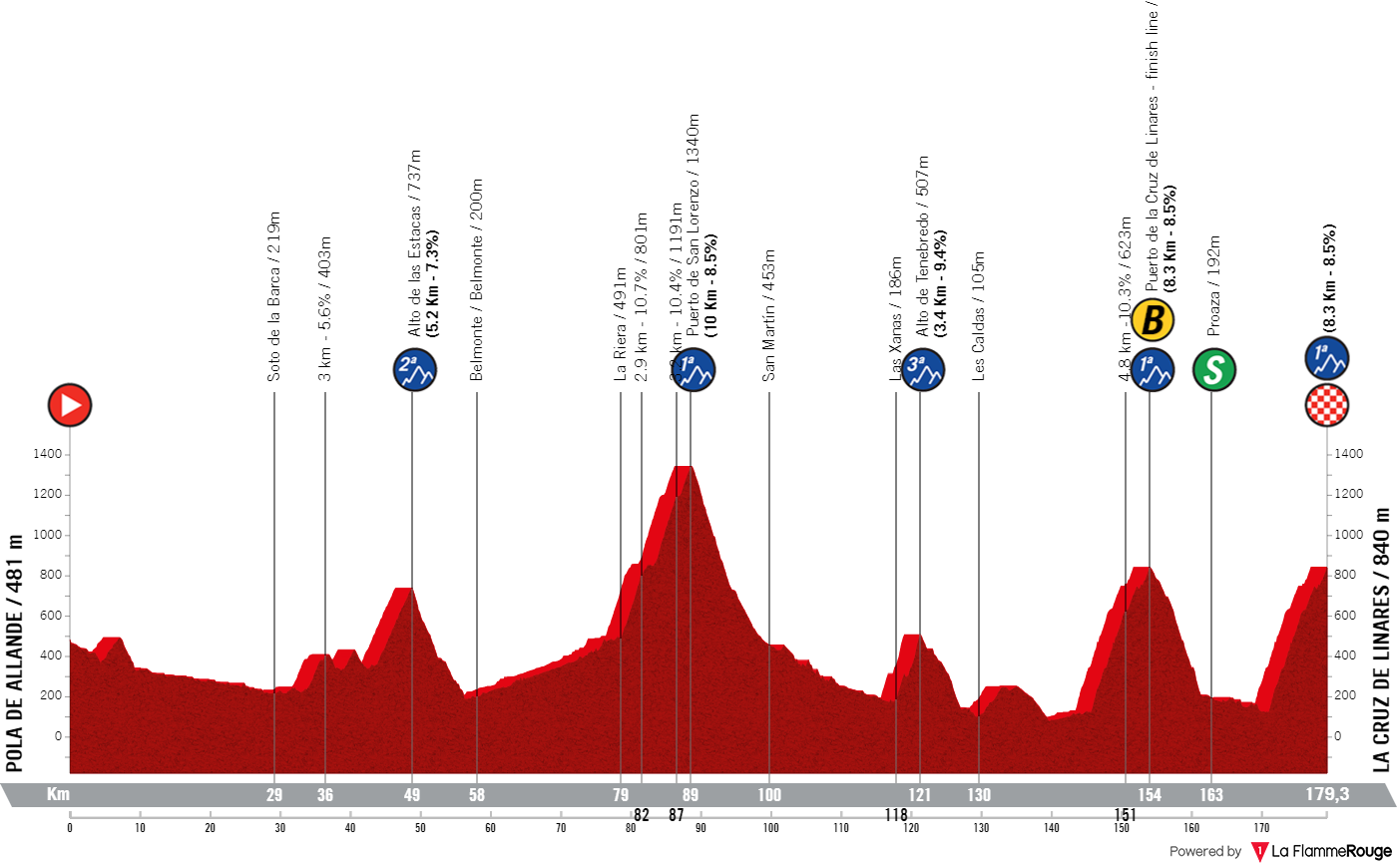
Stage 18 will be another brutal day in the Asturias, a proper high mountain stage with three first category climbs among others. The finale will be atop La Cruz de Linares which the riders will be riding up on two different occasions with 8.5 kilometers at 8%.
The start is not too difficult, but it does feature some hilltops early enough to see the climbers trying to form a strong group ahead. The race will begin to be really hard at the Puerto de San Lorenzo, it ends with 90 kilometers to go, unlikely a place for attacks because in reality much of the toughness on the day is still to follow, however it's 10 kilometers at 8.5% - which take into account a flat section - are enough to cause havoc.
The Alto de Tenebredo is an ascent I'd say the same about. It is shadowed by the brutal long ascents that sandwich it, but on it's own it's crazy hard, with 3.4 kilometers in length, most at above 10%, the average is close to it but it does feature a small descent. This one ends with 58 kilometers to go. But only then will the riders head into the final circuit where the big attacks are expected.
This will be a double ascent of La Cruz de Linares. The final true big climb of the race, it's 8.2 kilometers at 8.5% average gradient. Not the most constant climb, it features a bit of a plateau near the top, it also sees gradients almost constantly in the 10% in it's first half. A brutal one. The riders will summit it with 25 kilometers to go, and after a fast descent and small flat section, they will have to do it all over again.
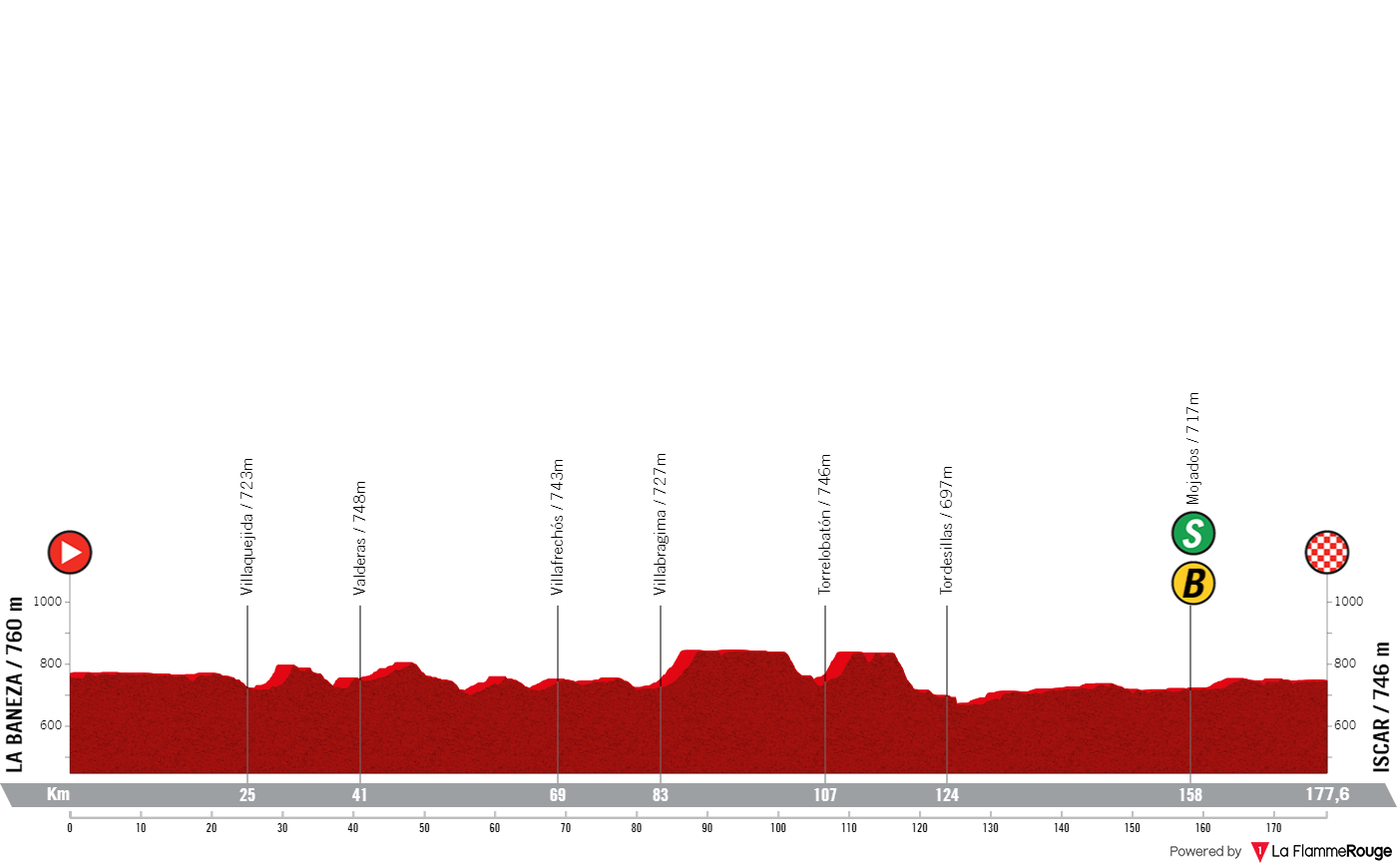
A transition stage. The 19th day of racing at the Vuelta a Espana will see the riders race from La Bañeza to Íscar on what is a perfect day for the sprinters. No climbing, no more small ring riding, it will be a well deserved calmer day in the peloton. That is of course, until the final kilometers, where for different reasons some will hit the front to protect their ambitions.
This stage will be all about the sprint - as long as the wind doesn't blow hard on the exposed plains the peloton will ride by. Technical features you won't see them, a very simple and plain finale, one that I can't throw any criticism because it diminishes the chances of there being crashes.
The final kilometers are pan-flat, the final corner will be there with 2.3 kilometers to go. It's a finale where timing will be key. There won't be thinning down or narrowing points, so it's a matter of coming to the front at the right time, a balance between staying in the wheels as late as possible and saving as much as possible within circumstances.
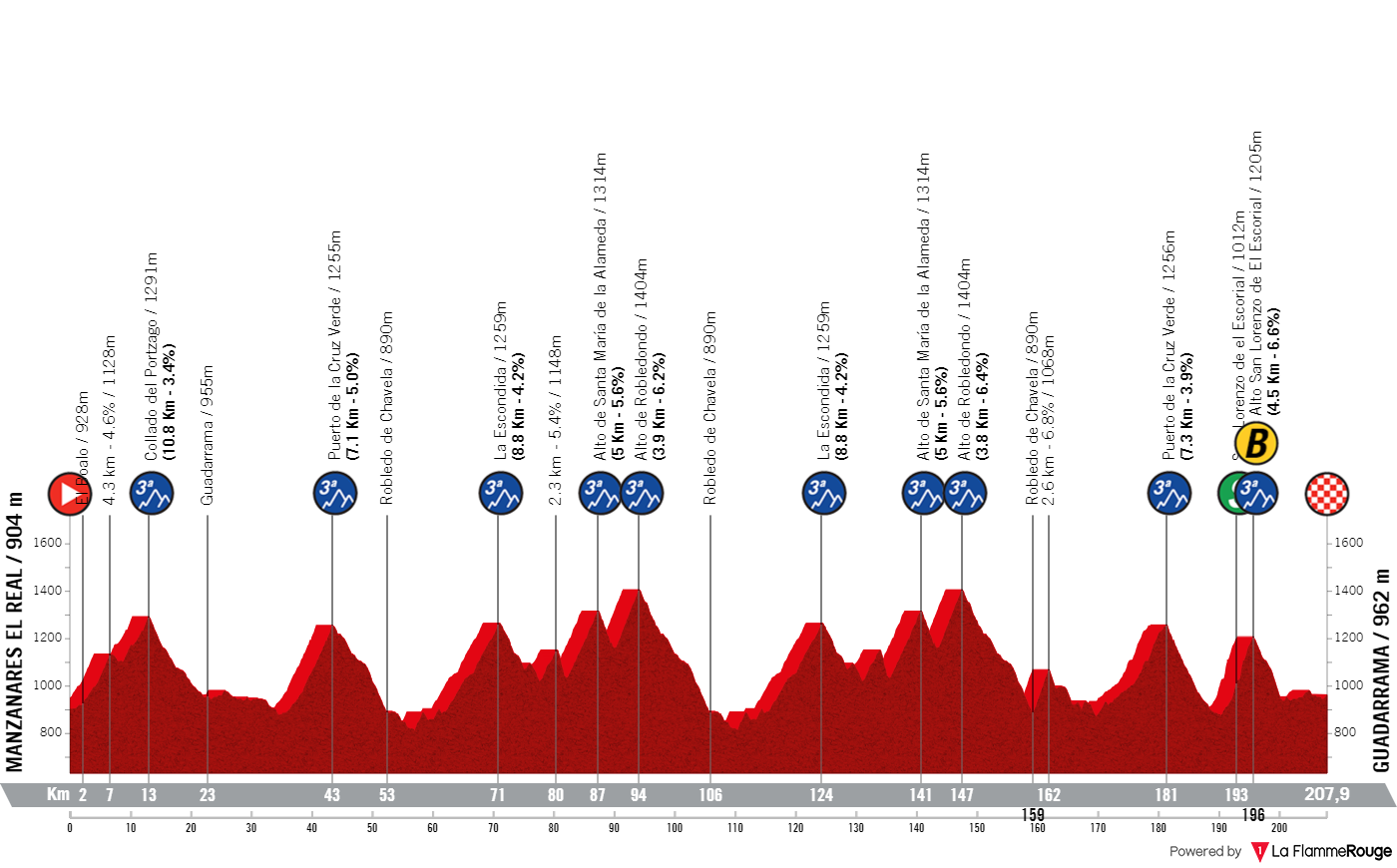
The final day of competitive racing. The Vuelta a Espana has once again surpassed itself in what has proven to be a very popular profile amongst fans. The day will not feature a single long ascent, but will be riddled with climbs throughout a whole 208 kilometers. It will be in the Sierra de Guadarrama that the race will be decided as the riders take on 10 categorized climbs and several others where the climbers may be out of their comfort zone and lose it all.
The final day of competitive racing. The Vuelta a Espana has once again surpassed itself in what has proven to be a very popular profile amongst fans. It is a confusing, messy, explosive day if you've ever seen one as a final GC challenge for a Grand Tour. It is in my eyes brilliant, the climbers have spent three weeks battling in the many mountain stages and summit finishes for the GC, but now in the final day they find a long day with 10 medium-sized categorized climbs, and plenty others.
It is a bumpy ride in the Sierra de Madrid. The riders can see the finale but they first have 4400 meters of climbing, without a single long ascent. The day starts off immediately with a 10.8 kilometer climb at 3.4% - which is on profile a combination of two hilltops. Then follows a 7.1Km climb at 5% which is ultimately the longest of the day.
Then two laps of a circuit with La Escondida (8.8Km; 4.2%), Alto de Santa Maria de Alameda (5Km; 5.6%) and the Alto de Robledondo (3.9Km; 6.2%). This can be a key part of the course, in the space of 32 kilometers the riders find four ascents and nothing but descents inbetween, no flat terrain whatsoever (on both laps). On the final passage, they will have 84, 67 and 61 kilometers to the finish. After it's descent comes another uncategorized ascent with 2.6Km at 6.8% which ends at 46 kilometers to the finish in Guadarrama.
Then the race can stabilize a bit, but it does not mean it'll get easier. The peloton tackles the Puerto de la Cruz Verde which is 7.3 kilometers at 3.9%, featuring a steeper finale than the average gradient suggests. The descent is steep and fast into the final climb. The riders enter San Lorenzo de El Escorial, town which has hosted on many occasions the end of the stage when these mountains are tackled.
This time however the riders climb through town, the final ascent of this race is 4.5 kilometers long at 6.6%, not too hard but it features a section as steep at 18%. It's such a harsh finale to the climbing in this race, riders will already have almost 200 kilometers of roller-coaster by this moment and the slightest of weak moments can lead to big losses and a complete change in the GC.
The riders descent back into the plain and then the final 8 kilometers will be flat. This will lead those who survived into Guadarrama for the finale of the stage, gaps aren't expected but there is still a mean ramp to the finish line.
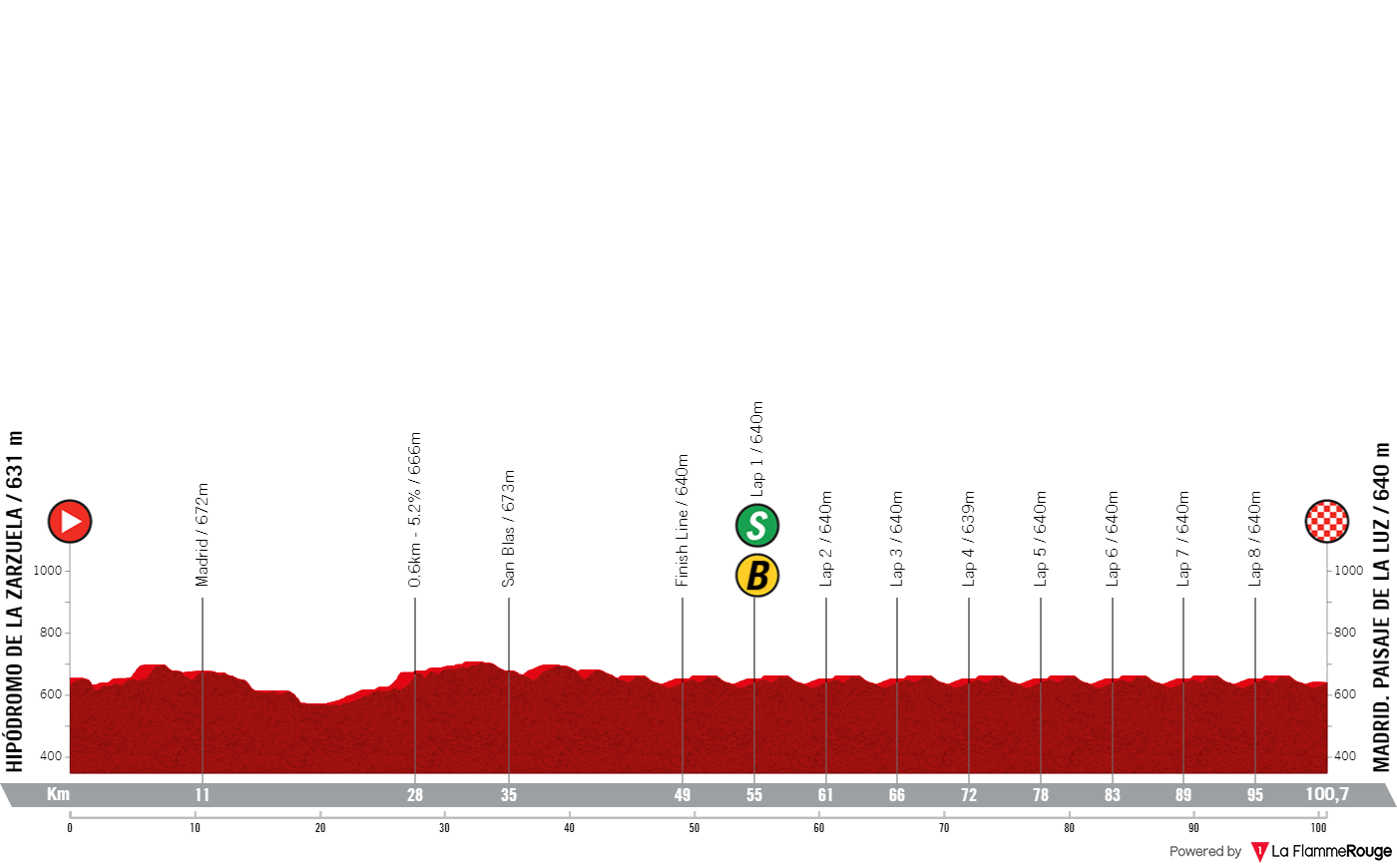
The race finally reaches it's end, into Madrid. A short flat day with no difficulties, it will be a big reward for the fast men who've survived a brutal race to make it into Madrid.
The day will see the peloton ride into the city where they will tackle a 5.8-kilometer circuit a total of nine times. The riders will have an 180 degree turn with 3.5 kilometers to go and a sharp right hander with 2.4 which will be natural selection points, with the bunch stretching out. The final straight will be 1.1 kilometers long after a long roundabout, with the bunch sprint set to be a regular one, hopefully with no crashes in sight.











Place comments
0 Comments
You are currently seeing only the comments you are notified about, if you want to see all comments from this post, click the button below.
Show all comments